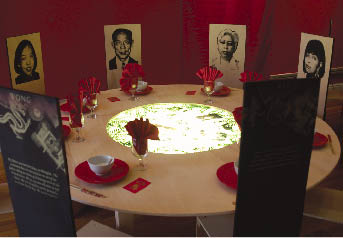Borders Crossed: Tomie Arai at CEPA Gallery
by Cynnie Gaasch

Birch plywood cut and formed into tables and chairs become the canvas for Tomie Arai’s “Double Happiness,” an installation that fills CEPA Gallery’s first floor gallery in the Market Arcade as part of the current exhibit “Tomie Arai: Untelling.” A Chinese wedding banquet is attended by a group which is entirely bi-racial, all part Chinese and part Latin American or Caribbean: Guatemalan, Jamaican, Caribbean, and Haitian. A bit of each “guest’s” oral history is documented on the back of each seat, and a black and white silk screen print of their face is on the front. The tools of printmaking bring to life a three-dimensional feast for the eyes and mind with walls painted red and Latin dancing music piped in over the speaker system.
“Untelling” is a mid-career retrospective for this New York-based artist of works that are touched by her experience of the world as an American with Japanese heritage. Arai is well known for her community-based work, including murals and mosaics on the Lower East Side of Manhattan. She incorporates this sense of community in much of her work by printing sections of oral histories in and on the prints and objects. She has received grants from the NEA and the New York Foundation for the Arts, and has exhibited extensively, including at the Museum of Modern Art and the Whitney Museum of American Art as well as numerous commissions for public art. Curated by UB visual arts professor Millie Chen, the exhibition includes more “traditional” prints from the early 1990s through installations created in 2003.
The wedding banquet in “Double Happiness” is at first glance a gathering of an extended Chinese family to celebrate, complete with red walls, wall hangings, and family pictures. The tables, chairs and hangings are decorated with iconic Asian themes—waves dragons—and heirloom objects. As you absorb the visual and read the biographies, you slowly realize the complicated histories of individuals Arai interviewed in New York. Each with a different story of parents and grandparents and Chinatowns throughout South America, their histories conflate, creating a beautiful image of the unfolding multi-racial world we live in. At the same time, Arai is clearly expressing the frustration of these multi-ethnic individuals who are constantly confronted with questions about their heritage, and frustration at always being singly understood at Chinese.
“Urashima” is an ancient Japanese folk tale that describes an imaginary, fantasy place that does not exist, with the moral to be satisfied with your fate. Arai retells the story in this installation with the same title, creating a world of the morphing diasporas of immigrants and emigrants. She explores the experience of neither belonging here nor there. The installation is surrounded by warm red walls and contains a populated fish tank, and a multi-panel screen that creates a workspace with a tabletop covered by the artist’s work. For the original installation in 2003in New York City, Arai sat at the worktable silk-screening hybrid traditional images onto pages from contemporary magazines. In Buffalo, the mix of images loosely piled behind the screen is surprising as to how the black silk-screened images gel with the colorful, fashionable advertising motifs.
“Tomie Arai: Untelling” remains on view through January 14. An installation including video is available for viewing on Main Street, in the Flux Gallery 24/7.
|
Issue Navigation> Issue Index > v5n1: How Stupid is Your Daily Paper? (1/5/06) > Borders Crossed: Tomie Arai at CEPA Gallery This Week's Issue • Artvoice Daily • Artvoice TV • Events Calendar • Classifieds |









 Current Issue
Current Issue